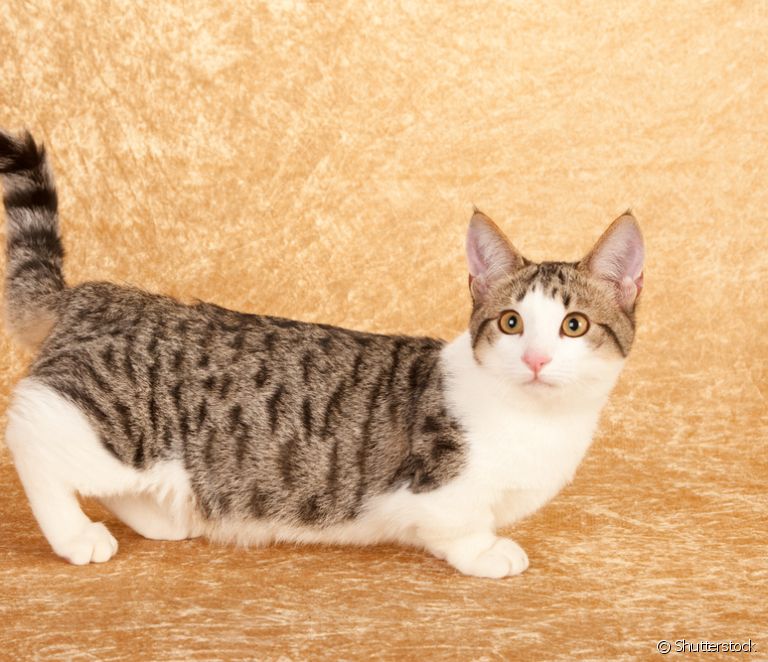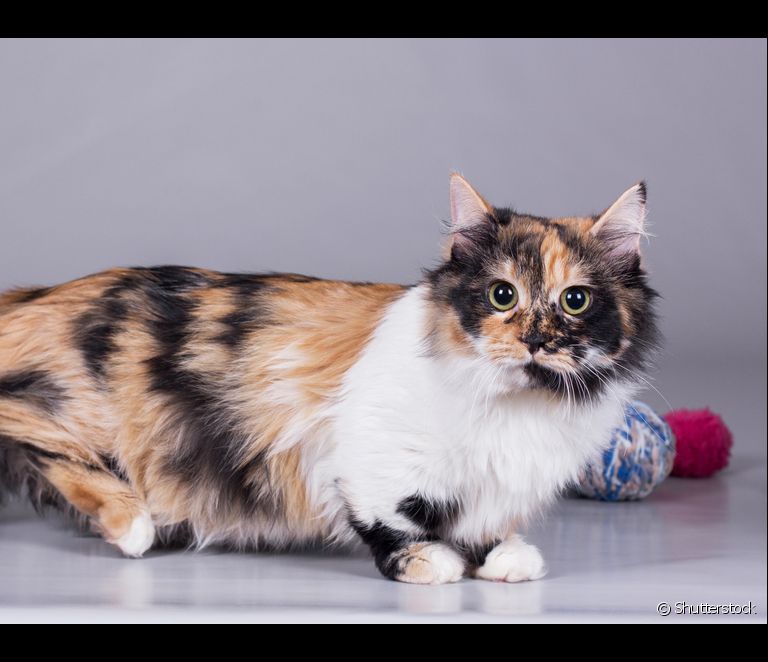Munchkin: curiosities, origin, characteristics, care and personality... everything about the "sausage cat"

Table of contents
Dwarf and sausage cat are some names used to refer to the Munchkin cat, an adorable feline with short legs and an elongated spine. The short-legged cat is not one of the most popular in Brazil, but it certainly draws attention for its "differentiated" physical form. Very sweet and full of energy, the Munchkin is a mixture of cuteness, intelligence and companionship. The Munchkin cat, in the ...However, it is the result of a genetic mutation and its origin is somewhat controversial, so many people question whether this "deformity" is an act of cruelty or not.
After all, does the Munchkin cat suffer from its physical condition or does it have difficulties getting around? Does it need any special care because of its short legs and elongated spine? Can the animal develop any health problems as a result? What is the personality of this dwarf cat like? To answer all your questions about the Munchkin, we have prepared a complete guide with all the information about the Munchkin cat.race.
Munchkin: where did the short-legged cat come from?
The Munchkin wasn't always considered a super cute kitten, in fact, his breeding received a lot of criticism in the beginning and he was even considered a freak. The origin of the breed is marked by many controversies. According to TICA (The International Cat Association), a British veterinarian recorded in 1944 at least four generations of felines with short legs and who wereconsidered healthy. The lineage disappeared after the second world war.
Still according to the association, the Munchkins we know today began to establish themselves in 1983 in Louisiana, in the United States, when a teacher found a cat that had short legs and an elongated back - and an important detail is that she was pregnant. The kitten was named Blackberry and is considered the "progenitor" of the breed. She and one of her kittens, named afterToulouse, were crossed with other domestic cats and thus the breed was established with the characteristics we know of the short-legged cat today.
The short-legged cat was accepted and registered in TICA's breed program in 1994. The institution monitors the creation and development of genetic standards for new breeds. TICA points out that the breeding of short-legged cats follows the formats of dog breeds that have similar characteristics, such as the Dachshund and the Corgi. The feline gained champion status in 2003.
There are a few theories regarding the breed's name and one of them is the reference to the Wizard of Oz. It is believed that the new creation got its name after the felines started to reproduce rapidly in Louisiana, thus generating a colony of dwarf cats. They were everywhere, just like in the "Land of the Munchkins" created by the writer L. Frank Baum.
See_also: Cat with intestinal infection: can it be prevented?Downgraded cat: Munckin breed has trait due to genetic mutation
The Munchkin cat is the result of a spontaneous genetic mutation. Munchkin cats have an autosomal dominant gene that prevents their leg bones from growing evenly. A cat only needs one copy of the gene to be born with this trait - i.e. if the female cat has short legs and the male cat is a "normal" cat, the kitten generated by crossing the two animals canNormally, this is how a breed line is created: if the embryo receives two genes with that trait, it is very likely that it will not survive.
There are long legged kittens that carry the short legged gene and can be mated with a Munchkin or "normal" cats in an attempt to generate healthy kittens of the breed.
Munchkin: "dwarf cat" has other physical characteristics besides short legs
The lowered Munchkin cat usually does not exceed 5 kg and varies between small and medium size. Even with short legs, there is no change in their size. Generally, males are larger than females. The rounded face shape and large (and very penetrating) eyes are some of the characteristics of this pet. And besides having short legs, the breed also carries another curiosityon that part of the body: it is normal for the hind legs to be longer than the front legs.
The Munchkin cat is also very multifaceted when it comes to coat. The animal can present a varied palette of colors and combinations of tones. According to TICA, these colors were introduced from a crossbreeding program that does not alter the genetics of the breed. In a quick search on the internet, it is possible to find some very curious variations, such as a "Munchkin Sphynx" (a cat without a coat).The association, however, points out that the Munchkin is a unique breed and not a smaller version of other cat breeds. The animal has a soft, medium coat that is very fluffy and adapts to all seasons, but there is a recognized variation of the breed that has longer hair.
See a gallery with Munchkin cat photos to fall in love with!















Short-legged cat: what's the Munchkin's personality like?
The Munchkin cat is the combo of cuteness: apart from the body shape that makes you want to squeeze just by looking at it, the short-legged cat's behaviour is very docile and friendly. This dwarf cat gets along very well with everyone, including children and other animals, and is very sociable. They like to spend a lot of time with their owners. On the other hand, don't be fooled by this small body: the short-legged cat isSome theories say that the creation of the breed was intended to create a cat that was more agile and could make more accurate turns. And the shape of his little body does not prevent him from climbing places: therefore, it is important that he has a well "catified" house to express his instincts. The only caution should be with the descent from higher places.
The Munchkin's curiosity and intelligence are great allies for having a very obedient animal at home. You can even perfect this by teaching your kitten some tricks. This will sharpen his cognitive skills and improve communication between animal and guardian. Cat training is a way to strengthen the bond between you. For sure, your cat with short legs will love it!learn the tricks.
In addition, the socialization of the Munchkin dwarf cat is essential so that the feline learns to trust the owners, deal with strange people and animals and get used to the dynamics of the carrier box. Doing this process from an early age avoids a series of disorders in the future.
Munchkins: cat breed has several curiosities
- The UK's main feline registration body does not officially recognize the Munchkin cat. Health problems as a result of the genetic mutation are the main reason for this.
- "How big is the Munchkin cat?" Breed size is one of the main curiosities. The dwarf cat breed is about half the size of a normal kitty.
- The fur of this kitten can be short or long, but any specimen will feature a thick coat that makes the weather no problem for the Munchkin: short-legged cat breed will always possess this characteristic.
- The small pawed cat is known to love shiny things and have a habit of hiding them, so the adult Munchkin guardian needs to be careful where they keep jewelry and other valuables.
Can a cat with a short leg have health problems due to the trait?
There are some disagreements regarding the breeding and health of the Munchkin breed. While some associations consider it an unethical result of cross-breeding, other entities and breeders assure that the Munchkin's body shape does not interfere at all with its mobility and is not a factor in the development of joint and bone diseases. Overall, the short-legged cat is very healthy andHowever, it is always important to check the general state of your cat's health, especially since it is a very agitated animal. Therefore, if you find your cat with short legs limping, with signs that it is in pain or with difficulties getting around, take it to the vet immediately.
Munchkin cat and the general care it needs
- Nails The Munchkin is a short-legged cat that usually does not require very specific care. The attention of the guardian with the trimming of the nails is fundamental so that the cat breed Munchkin does not damage the furniture with its nails.
- Physical exercises frequent check-ups, up-to-date deworming, vaccinations and parasite control are also essential to keep the animal in good health.
- Coat The Munchkin's routine should also include frequent brushing of the coat. This way, the short-legged cat's coat will remain fluffy and silky.
- Food With its different body shape, the Munchkin cat breed must not be overweight so as not to lose quality of life. Choose a food suitable for the cat's age and pay attention to the amount offered as well. Attention to adequate water intake to stay away from kidney and urinary diseases is also essential.for the short-legged cat.
Short-legged cat: Munchkin kitten will need time to adjust to new home
The Munchkin mini cat, as a kitten, will need some time to adapt to the new home. Felines are not the only animals best known for dealing with changes, even in this first phase of life. Therefore, it is important that the guardian has patience. What can help in this process is the interaction of the two with games and also through training. Without forgetting the basic carewith cat vaccination and deworming that every kitten needs, whether it is a short-legged cat breed or not.
See_also: 5 reasons behind the dog biting its pawMunchkin: cat breed costs from $ 2,000 to $ 5,000
Coming here, you might be wondering how much you have to shell out to own a Munchkin dwarf cat. Price of the short-legged cat breed ranges between $2,000 and $5,000, which is considered more expensive compared to other breeds like the Persian and the Siamese. However, it is still cheaper than a Maine Coon kitten, for example. When deciding to own a short-legged cat breed animal, researcha lot and look for reliable and certified breeders.
X-ray of the Munchkin cat breed: summary of information about them
- Porte: small
- Average height: 17 to 23 cm
- Weight: 2.5 kg to 4 kg
- Colors: multiple
- Life expectancy: 10 to 15 years
- Coat: short and long

